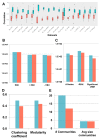Molecular Inverse Comorbidity between Alzheimer's Disease and Lung Cancer: New Insights from Matrix Factorization
- PMID: 31247897
- PMCID: PMC6650839
- DOI: 10.3390/ijms20133114
Molecular Inverse Comorbidity between Alzheimer's Disease and Lung Cancer: New Insights from Matrix Factorization
Abstract
Matrix factorization (MF) is an established paradigm for large-scale biological data analysis with tremendous potential in computational biology. Here, we challenge MF in depicting the molecular bases of epidemiologically described disease-disease (DD) relationships. As a use case, we focus on the inverse comorbidity association between Alzheimer's disease (AD) and lung cancer (LC), described as a lower than expected probability of developing LC in AD patients. To this day, the molecular mechanisms underlying DD relationships remain poorly explained and their better characterization might offer unprecedented clinical opportunities. To this goal, we extend our previously designed MF-based framework for the molecular characterization of DD relationships. Considering AD-LC inverse comorbidity as a case study, we highlight multiple molecular mechanisms, among which we confirm the involvement of processes related to the immune system and mitochondrial metabolism. We then distinguish mechanisms specific to LC from those shared with other cancers through a pan-cancer analysis. Additionally, new candidate molecular players, such as estrogen receptor (ER), cadherin 1 (CDH1) and histone deacetylase (HDAC), are pinpointed as factors that might underlie the inverse relationship, opening the way to new investigations. Finally, some lung cancer subtype-specific factors are also detected, also suggesting the existence of heterogeneity across patients in the context of inverse comorbidity.
Keywords: Alzheimer’s disease; inverse comorbidity; lung cancer; matrix factorization; networks; transcriptome.
Conflict of interest statement
The authors declare no conflict of interest.
Figures




References
-
- De Sousa E., Melo F., Wang X., Jansen M., Fessler E., Trinh A., de Rooij L.P.M.H., de Jong J.H., de Boer O.J., van Leersum R., et al. Poor-prognosis colon cancer is defined by a molecularly distinct subtype and develops from serrated precursor lesions. Nat. Med. 2013;19:614–618. doi: 10.1038/nm.3174. - DOI - PubMed
MeSH terms
LinkOut - more resources
Full Text Sources
Medical
Research Materials
Miscellaneous

